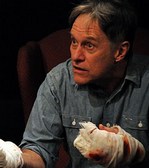SITE GUIDE
SEARCH
REVIEWS
REVIEW ARCHIVES
ADVERTISING AT CURTAINUP
FEATURES
NEWS
Etcetera and
Short Term Listings
LISTINGS
Broadway
Off-Broadway
NYC Restaurants
BOOKS and CDs
OTHER PLACES
Berkshires
London
California
New Jersey
DC
Connecticut
Philadelphia
Elsewhere
QUOTES
TKTS
PLAYWRIGHTS' ALBUMS
LETTERS TO EDITOR
FILM
LINKS
MISCELLANEOUS
Free Updates
Masthead
A CurtainUp Review
Safe Home
|
I have another son, Pat, the kids all call Tooth, because he refuses to get a cap. And a third son, John, they call Tojo because he has buckteeth. And Jimmy himself must be lucky because he has the only teeth in the family that don't need fixin.—Tristram
|

Michael Cullen as Jim Sr.
(Photo: Alex Koch) |
Cullen's writing was inspired by his grandparents, Ada and Jim, who lived with their three sons, Jimmy, Pat and Cullen's father, John, in Buffalo, New York. The play focuses on Uncle Jimmy, who was killed in the Korean War, but not before he sent home "from a cold and lonely outpost in Korea" an 8-page letter. " This —shockingly poignant document" was discovered by Cullen's sister Colleen two summers ago.
Prior to its currentl staging by Chris Henry & Royal Family Productions as part of The Intterart Theatre Development Series, Safe Home received its first workshop production at New York's CAP 21 in 2008 after readings at Lincoln Center Theater, Primary Stages, and at Stanford University by the American Conservatory Theatre. With such a pedigree, it's hard to understand why the final product is so unfocussed and confused.
Part of the problem is in the writing. Cullen tells his story in eight scenes. The first scene takes place in August 1952 when Ada (Cynthia Mace) and Jim ((Michael Cullen) Hollytree find out that their son, Jimmy, (Eric Miller), also known as Lucky, has been killed in the war. The subsequent scenes alternate between continuing the storyline of what happened after Jimmy's death and flashbacks explaining why Jimmy enlisted in the first place.
Not surprisingly, Jimmy had a dysfunctional family. His mother is a nut job who is incapable of showing love to either her husband or children. She spends most of her time nagging or swaddled in a blanket. When she has outbursts they can be quite violent; at one point she slashes Jimmy's brother Pat (Erik Saxvik), also known as Tooth, with a screwdriver. His father does something with radiators that causes his hands to bleed. He is mostly passive, except when he gets angry, at which times he can be almost as abusive as his wife.
Redemption arrives, with Claire Baggot (Katy Wright Mead), a young lady to whom Jimmy declares his love the night he is leaving home to join the Marines. This scene is awkward, overly long and predictable (there is a downpour that arrives with dramatically perfect timing).
There are also a few scenes that just make no sense, most notably the one in which Pat tries to open Jimmy's coffin because he thinks his brother's body may not be in it. But the one in which Jimmy seems to be trying to take over his father's job is a close runner-up.
Director Chris Henry, who might have given the play some cohesiveness, seems just as confused as the writer. There is little indication that under her direction the actors were able to determine why they are on stage or what they are doing. Michael Cullen, as the perplexed and ineffectual head of the family cannot get his character to rise above a cliché. Mace, a fine and capable actress, tries her best to give Ada something of a sympathetic personality and at times she is almost successful. But for the most part, lines are recited, emotions are revealed and the play moves on to the next scene.
The apartment the Hollytrees live in closely resembles that of Ralph and Alice in the Honeymooners. It even has a drab window, most probably facing an alleyway. Only in this theater it's a very real window. Most inexcusably, in the middle of the play, Henry has one of his actors open that window, and even though the temperature during a New York City winter frequently dips into the 20s, the window remains open until the play's end. Whatever was she thinking?
What is the lesson of
|
Safe Home By Sean Cullen Directed by Chris Henry Cast: Cynthia Mace (Ada Hollytree), Michael Cullen (Jim Hollytree), Eric Miller (Jimmy Hollytree), Erik Saxvik (Pat Hollytree), Ian Hyland (John Hollytree), Katy Wright Mead (Claire Baggot) Set and Projection Design: Alex Koch Costume Design: Lena Sands Lighting Design: David Bengali Sound Design: Jeanne Wu Running Time: 90 minutes Presented by Chris Henry & Royal Family Productions at Women's Interart Center, 500 West 52nd St. From 1/8/10; opening 1/14/10; closing 2/14/10 Friday & Saturday at 8pm, Sunday at 5pm, Monday at 7pm, with added performances Jan. 14 at 8pm, and Jan. 31 at 8:30pm Tickets: $18 (212) 868-4444 or SmartTix.com Reviewed by Paulanne Simmons Jan. 9, 2010 |
|
REVIEW FEEDBACK Highlight one of the responses below and click "copy" or"CTRL+C"
Paste the highlighted text into the subject line (CTRL+ V): Feel free to add detailed comments in the body of the email. . .also the names and emails of any friends to whom you'd like us to forward a copy of this review. You can also contact us at Curtainup at Facebook , Curtainup at Twitter and at our Blog Annex |
|
Subscribe to our FREE email updates with a note from editor Elyse Sommer about additions to the website -- with main page hot links to the latest features posted at our numerous locations. To subscribe,
E-mail: esommer@curtainup.comesommer@curtainup.com
put SUBSCRIBE CURTAINUP EMAIL UPDATE in the subject line and your full name and email address in the body of the message -- if you can spare a minute, tell us how you came to CurtainUp and from what part of the country. |





